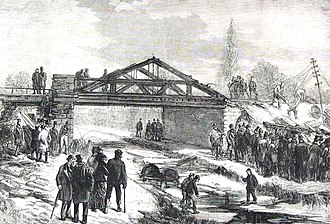Shipton-on-Cherwell Railway Accident

In the Shipton-on-Cherwell railway accident on December 24, 1874, an express train derailed after a tire broke on the Cherwell Valley Line of the Great Western Railway near Shipton-on-Cherwell , Oxfordshire , England . 34 dead and 65 seriously injured were the result. The causes of the accident were a number of technical defects and operational inadequacies.
requirements
The express train was on its way from London Paddington to Birkenhead . The fully occupied train with 14 passenger cars received a leader locomotive and an older two-axle reinforcement car, which had been built in 1855 , in Oxford . It was placed behind the locomotives . Here also had communication line with the traveler or the train crew the bell on a Tender could ring to draw the attention of the locomotive personnel upon himself to be reattached, but what happened inadequate. Continuous brakes were still unknown at the time. Rather, the train has been exclusively from the locomotive and on some cars ride- brakemen braked, the braking due to their served Pfeifsignals the locomotive.
the accident
Due to the low temperatures on the day of the accident and the high speed of almost 70 km / h, a tire on the reinforcement car broke. The car derailed. Since travelers and train crew could not alert the locomotive crew due to the inadequately installed communication line, they only became aware of the danger shortly before the bridge over the Oxford Canal . It braked immediately with full force without the train's brakes being able to react. The brakes of the locomotives worked faster than those of the rest of the vehicles on the train, which hit the locomotives and crushed the reinforcement car. Nine of the following cars fell down the embankment with their passengers , some in the Oxford Canal, three derailed without falling, only the last two remained on the track . Most of the dead and injured traveled in the wagons that had fallen into the canal. Thanks to the caution of the train crew, a collision with the following train was prevented.
examination
The causes of the accident were determined to be: the outdated and dangerous design of the wheels of the reinforcement car built in 1855, perhaps there was also material fatigue , the failure of the communication line, the braking of trains by brakes on individual cars and the emergency braking of the locomotives.
consequences
The accident clearly showed the inadequacy of the braking system used on long and heavy trains. The accident accelerated the conversion to continuous compressed air or vacuum brakes . The commission of inquiry also recommended improved wheels, but still essentially made of wood. This problem should only be addressed with the introduction of wrought iron monoblock wheels. With regard to communication between train and locomotive personnel, the Commission recommended that a telegraphic procedure be introduced instead of the communication line. However, this proposal was not followed up.
See also
literature
- Peter R Lewis: Disaster on the Dee. Robert Stephenson's Nemesis of 1847 . Tempus 2007. ISBN 978-0-7524-4266-2
- Peter R Lewis and Alistair Nisbet, Wheels to Disaster !: The Oxford train wreck of Christmas Eve, 1874 . Tempus 2008. ISBN 978-0-7524-4512-0
- Lionel Thomas Caswell Rolt : Red for Danger . Edition: London 1978.
Web links
- Railways Archives, including investigation report
- exhibition
- Contemporary representation
- Article from 2006
Individual evidence
Coordinates: 51 ° 50 ′ 51 ″ N , 1 ° 17 ′ 56.7 ″ W.
